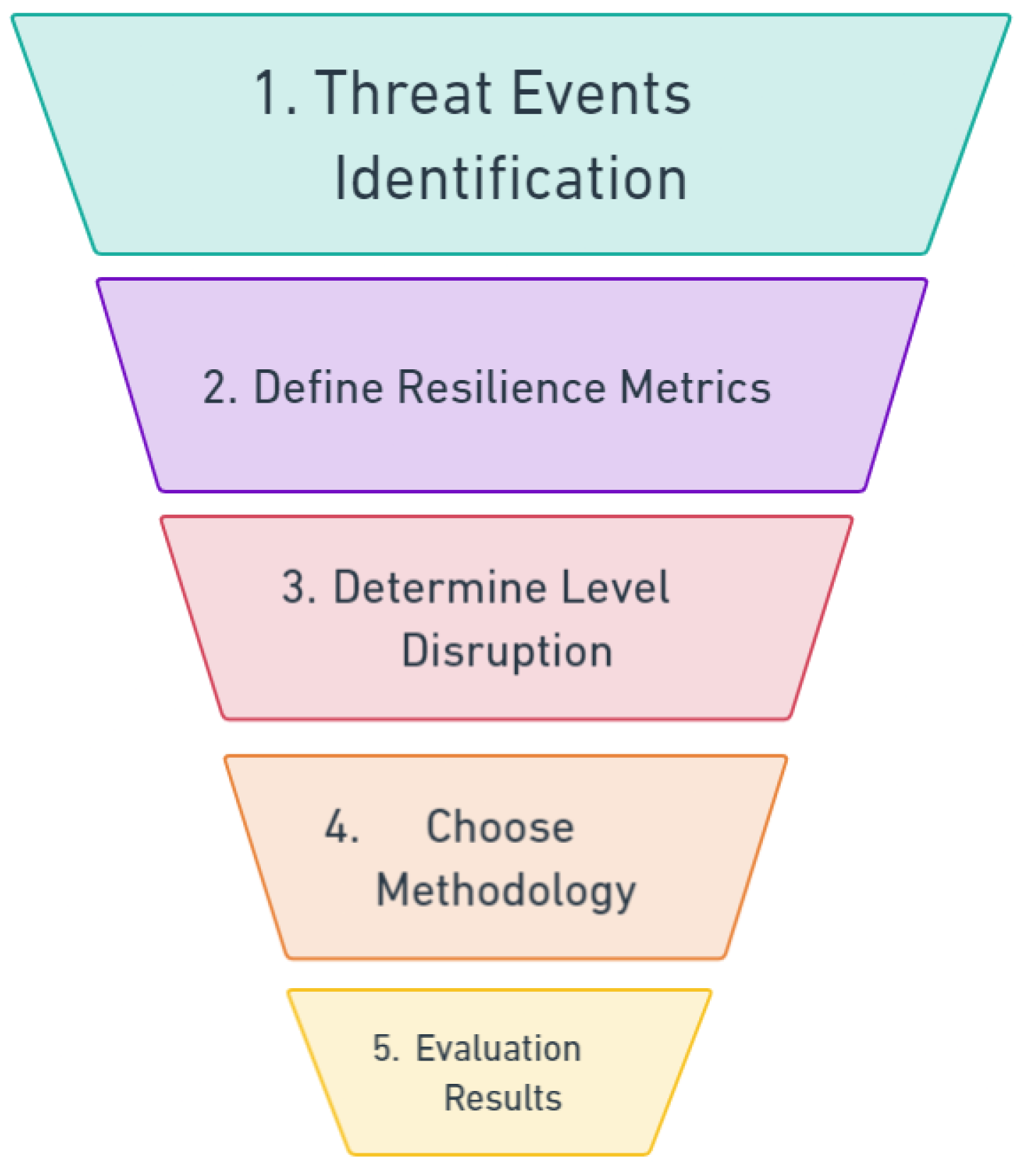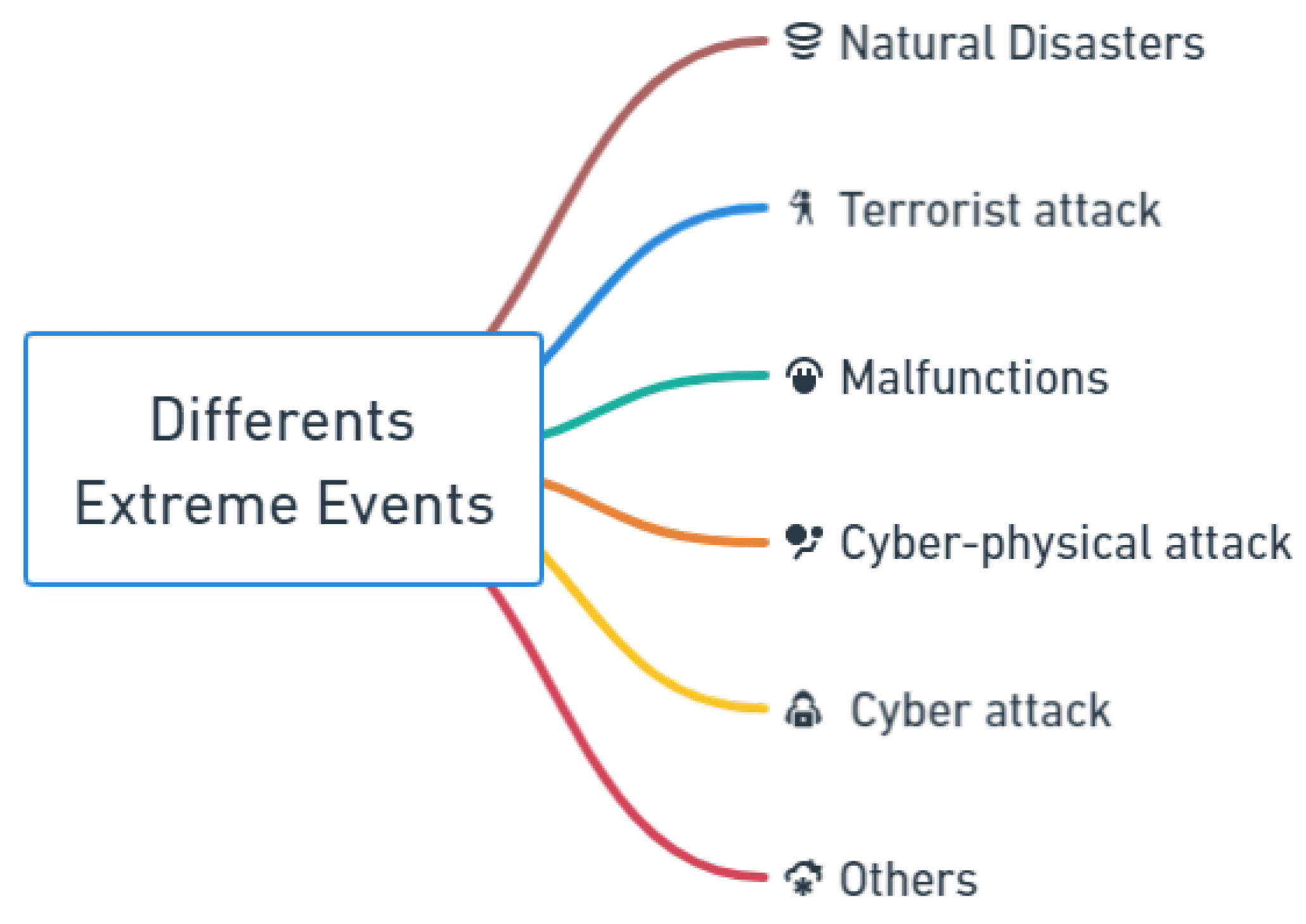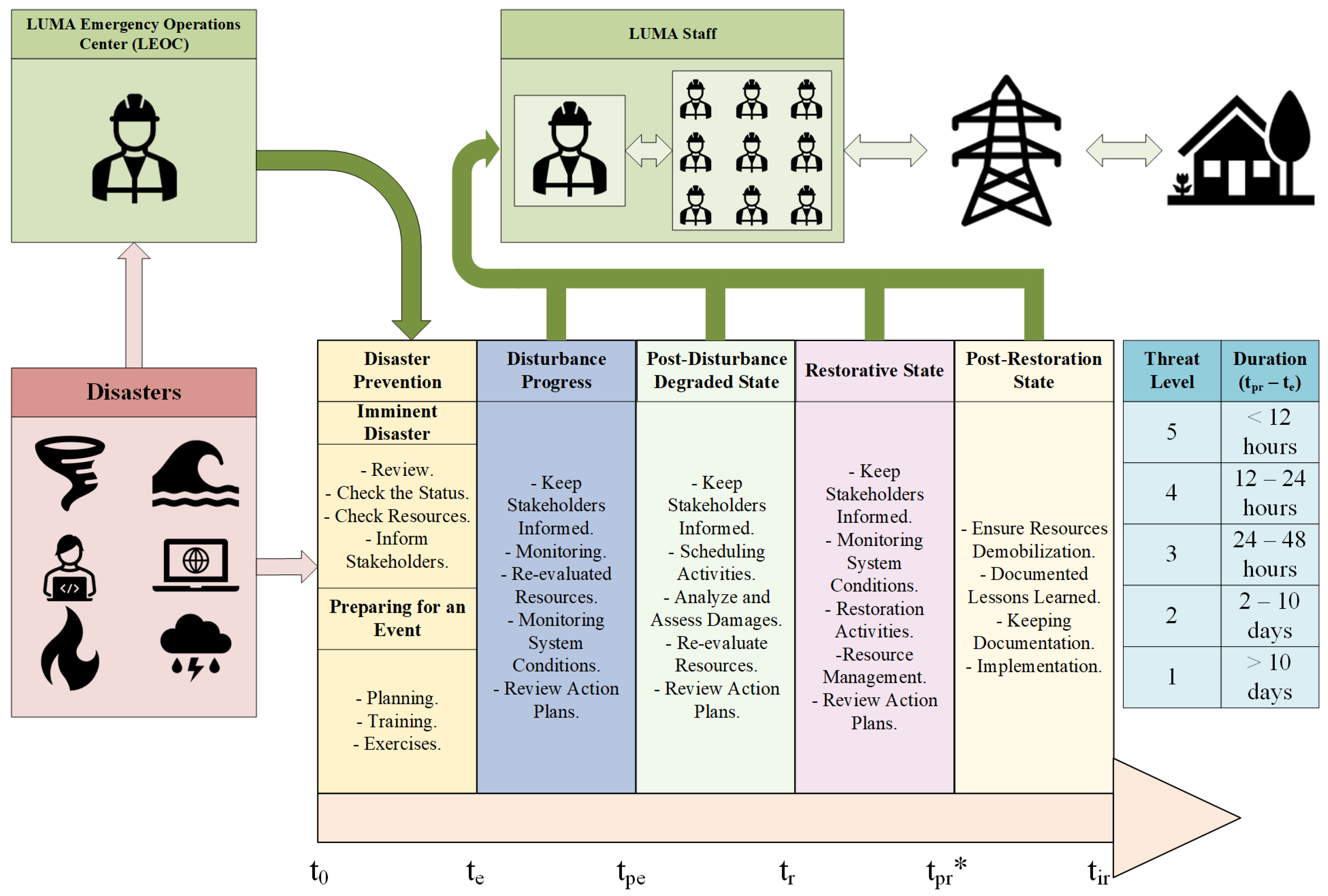Metrics and Strategies Used in Power Grid Resilience
Abstract
:1. Introduction
2. Concept of Grid Resiliency
- DOE:
- “The ability of a power system and its components to withstand and adapt to disruptions and rapidly recover from them” (www.energy.gov/eere/solar/solar-and-resilience-basics (accessed on 2 May 2023)).
- FERC:
- “The ability to withstand and reduce the magnitude and/or duration of disruptive events, which includes the capability to anticipate, absorb, adapt to, and/or rapidly recover from such an event” (The Federal Energy Regulatory Commission (FERC)).
2.1. Resilience Framework
2.2. Reliability and Resilience
2.3. Threat Events
- Natural hazards are caused by events like severe weather conditions, floods, earthquakes, hurricanes, landslides, frosts, and electrical storms. Additionally, they may result from interactions with wildlife, such as squirrels, snakes, or birds, which can lead to short circuits in distribution lines.
- Technological hazards are caused by failures of systems and structures, for example, defects in materials or malfunctions.
- Human-caused hazards can arise from accidents, such as inadvertently cutting a transmission line, or from intentional actions by an adversary, including cyberattacks or acts of terrorism.
2.4. Reliability and Resilience Metrics
2.4.1. Reliability Metrics
2.4.2. The Resilience Triangle
2.4.3. Resilience Trapezoid
2.4.4. Resilience Triangle versus Resilience Trapezoid
3. Resilience Strategies in Power Grids
3.1. Resilience as Seen by Grid-Side Operators— Top-to-Bottom Approach
3.1.1. Disaster Prevention
3.1.2. Disturbance Progress
3.1.3. Postdisturbance Degraded State
3.1.4. Restorative State
3.1.5. Postrestoration State
3.1.6. Resilience Cyber Attacks
- Threat probability ≡ mean of reproducibility + exploitability;
- Vulnerability probability ≡ detectability;
- Vulnerability impact ≡ mean damage + affected users.
3.2. Common Strategies Used by Users to Improve Resilience— Bottom-Up Approach
- Distributed Energy Resources (DERs): They pertain to diverse small-scale energy generation and storage technologies that can be deployed in proximity to the point of consumption, such as residences, businesses, and communities. These technologies encompass renewable energy sources, fuel cells, and energy storage systems, including batteries, as illustrated in Figure 8, positioned at levels I to IV. The adoption of distributed energy resources (DERs.) serves as a means to enhance the reliability and resilience of the electrical grid.
- Microgrid: This is a small-scale electrical grid that operates independently or in conjunction with an electrical grid. It usually consists of DERs such as PV, wind turbines, ESSs, and backup generators that are interconnected to supply power to a localized area at Level IV. Different architectures for building microgrids, including centralized, decentralized, and distributed forms, also provide construction flexibility depending on user needs. Microgrids offer several advantages over traditional power grids, including greater energy efficiency, greater reliability and resiliency, and integration of renewable energy sources and other DERs into the grid [34].
4. Discussion
- Load Growth: The continuous growth in load is a major problem due to the large number of new users connecting to the electric grid, which can cause grid infrastructure and equipment to exceed their design values and fail without the need for an extreme event.
- Climatic Variability: The challenges posed by climatic variability, marked by their heightened frequency and intensity, are considerable. In the United States, there has been a rise in power outages caused by weather events since the year 2000 (https://www.energy.gov/energysaver/articles/renewable-energy-and-energy-storage-can-help-you-power-through-natural (accessed on 13 October 2023)). Additionally, a substantial of all documented power outages in the U.S. are linked to weather-related incidents (https://fairtradefinder.com/the-benefits-of-portable-power-stations-for-natural-disasters/ (accessed on 13 October 2023)).
- Integration of Renewable Resources: While renewable energies are highly beneficial for increasing the reliability and resilience of users during power outages, when connected to the grid, they can cause damage due to the large amounts of injected energy, which can lead to failures.
- Supply Chain: Because more of the users use diesel or gas generation as a backup for the electrical grid, the supply chain is a problem, because generators can run out of fuel (https://www.datacenterknowledge.com/archives/2012/10/31/diesel-the-lifeblood-of-the-recovery-effort#close-modal (accessed on 15 October 2023)) because the fuel reserve was not sufficient or because trucks did not arrive at the generator site in time.
- Intelligence Control. Nowadays, grid operators and utilities are seeking to introduce more and more intelligent equipment to the grid, which can be controlled remotely in order to improve reliability by minimizing reconnection time after faults, but this is also a weak point and a target for cyber attacks like that conducted on the Ukraine power grid on 2022 (https://www.bbc.com/news/technology-61085480 (accessed on 22 October 2023)).
5. Future Research Directions
6. Conclusions
Author Contributions
Funding
Acknowledgments
Conflicts of Interest
Abbreviations
| CAIDI | Customer Average Interruption Duration Index |
| CI | Customers interrupted |
| CMI | Customer minutes interrupted |
| DERs | Distributed energy resources |
| DOE | U.S. Department of Energy |
| EIA | Energy Information Administration |
| ERP | Emergency response plan |
| ESS | Energy storage system |
| FERC | Federal Energy Regulatory Commission |
| IEEE | Institute of Electrical and Electronics Engineers |
| IoT | Internet of Things |
| MG | Microgrid |
| PV | Photovoltaic |
| SAIDI | System Average Interruption Duration Index |
| SAIFI | System Average Interruption Frequency Index |
| SG | Smart grid |
| T&D | Transmission and distribution |
References
- Shirzadi, S.; Nair, N.K.C. Power system resilience through microgrids: A comprehensive review. In Proceedings of the 2018 IEEE PES Asia-Pacific Power and Energy Engineering Conference (APPEEC), Kota Kinabalu, Malaysia, 7–10 October 2018; IEEE: Piscataway, NJ, USA, 2018; pp. 674–679. [Google Scholar]
- Gholami, A.; Shekari, T.; Amirioun, M.H.; Aminifar, F.; Amini, M.H.; Sargolzaei, A. Toward a consensus on the definition and taxonomy of power system resilience. IEEE Access 2018, 6, 32035–32053. [Google Scholar] [CrossRef]
- Izadi, M.; Hosseinian, S.H.; Dehghan, S.; Fakharian, A.; Amjady, N. A critical review on definitions, indices, and uncertainty characterization in resiliency-oriented operation of power systems. Int. Trans. Electr. Energy Syst. 2021, 31, e12680. [Google Scholar] [CrossRef]
- Mahzarnia, M.; Moghaddam, M.P.; Baboli, P.T.; Siano, P. A review of the measures to enhance power systems resilience. IEEE Syst. J. 2020, 14, 4059–4070. [Google Scholar] [CrossRef]
- Mar, A.; Pereira, P.; F. Martins, J. A survey on power grid faults and their origins: A contribution to improving power grid resilience. Energies 2019, 12, 4667. [Google Scholar] [CrossRef]
- Panteli, M.; Trakas, D.N.; Mancarella, P.; Hatziargyriou, N.D. Power systems resilience assessment: Hardening and smart operational enhancement strategies. Proc. IEEE 2017, 105, 1202–1213. [Google Scholar] [CrossRef]
- Mujjuni, F.; Betts, T.R.; Blanchard, R.E. Evaluation of Power Systems Resilience to Extreme Weather Events: A Review of Methods and Assumptions. IEEE Access 2023, 11, 87279–87296. [Google Scholar] [CrossRef]
- Hossain, E.; Roy, S.; Mohammad, N.; Nawar, N.; Dipta, D.R. Metrics and enhancement strategies for grid resilience and reliability during natural disasters. Appl. Energy 2021, 290, 116709. [Google Scholar] [CrossRef]
- Haggi, H.; Roofegari nejad, R.; Song, M.; Sun, W. A review of smart grid restoration to enhance cyber-physical system resilience. In Proceedings of the 2019 IEEE Innovative Smart Grid Technologies-Asia (ISGT Asia), Chengdu, China, 21–24 May 2019; pp. 4008–4013. [Google Scholar]
- Panteli, M.; Mancarella, P.; Trakas, D.N.; Kyriakides, E.; Hatziargyriou, N.D. Metrics and quantification of operational and infrastructure resilience in power systems. IEEE Trans. Power Syst. 2017, 32, 4732–4742. [Google Scholar] [CrossRef]
- Clark, A.; Zonouz, S. Cyber-physical resilience: Definition and assessment metric. IEEE Trans. Smart Grid 2017, 10, 1671–1684. [Google Scholar] [CrossRef]
- Rajkumar, V.S.; Tealane, M.; Ştefanov, A.; Presekal, A.; Palensky, P. Cyber Attacks on Power System Automation and Protection and Impact Analysis. In Proceedings of the 2020 IEEE PES Innovative Smart Grid Technologies Europe (ISGT-Europe), Hague, The Netherlands, 26–28 October 2020; pp. 247–254. [Google Scholar] [CrossRef]
- Wang, W.; Lu, Z. Cyber security in the smart grid: Survey and challenges. Comput. Netw. 2013, 57, 1344–1371. [Google Scholar] [CrossRef]
- Baumeister, T. Literature review on smart grid cyber security. Collab. Softw. Dev. Lab. Univ. Hawaii 2010, 650, 1–30. [Google Scholar]
- Salvi, A.; Spagnoletti, P.; Noori, N.S. Cyber-resilience of Critical Cyber Infrastructures: Integrating digital twins in the electric power ecosystem. Comput. Secur. 2022, 112, 102507. [Google Scholar] [CrossRef]
- Naseer, A.; Naseer, H.; Ahmad, A.; Maynard, S.B.; Siddiqui, A.M. Real-time analytics, incident response process agility and enterprise cybersecurity performance: A contingent resource-based analysis. Int. J. Inf. Manag. 2021, 59, 102334. [Google Scholar] [CrossRef]
- Ahmad, A.; Maynard, S.B.; Desouza, K.C.; Kotsias, J.; Whitty, M.T.; Baskerville, R.L. How can organizations develop situation awareness for incident response: A case study of management practice. Comput. Secur. 2021, 101, 102122. [Google Scholar] [CrossRef]
- U.S. Department of Energy. Puerto Rico Energy Recovery and Resilience Newsletter; U.S. Department of Energy: Washington, DC, USA, 2023.
- Sotomayor, F. Puerto Rico’s Electric Power System: An Analysis of Contemporary Failures and the Opportunity to Rebuild a More Resilient Grid, including the Development of a Utility-Scale Solar Farm on the Island Municipality of Culebra. Master’s Thesis, Master Clark University, Worcester, MA, USA, 2020. [Google Scholar]
- Kwasinski, A.; Andrade, F.; Castro-Sitiriche, M.J.; O’Neill-Carrillo, E. Hurricane Maria effects on Puerto Rico electric power infrastructure. IEEE Power Energy Technol. Syst. J. 2019, 6, 85–94. [Google Scholar] [CrossRef]
- Cox, S.L. Understanding Power System Threats and Impacts; U.S. Department of Energy: Washington, DC, USA, 2019. [CrossRef]
- Tierney, K.; Bruneau, M. Conceptualizing and measuring resilience: A key to disaster loss reduction. TR News 2007, 14–17. [Google Scholar]
- IEEE 1366-2012-IEEE; Guide for Electric Power Distribution Reliability Indices. IEEE Standards Association: New York, NY, USA, 1998.
- Cimellaro, G.P.; Reinhorn, A.M.; Bruneau, M. Framework for analytical quantification of disaster resilience. Eng. Struct. 2010, 32, 3639–3649. [Google Scholar] [CrossRef]
- Jufri, F.H.; Widiputra, V.; Jung, J. State-of-the-art review on power grid resilience to extreme weather events: Definitions, frameworks, quantitative assessment methodologies, and enhancement strategies. Appl. Energy 2019, 239, 1049–1065. [Google Scholar] [CrossRef]
- Attoh-Okine, N.O.; Cooper, A.T.; Mensah, S.A. Formulation of Resilience Index of Urban Infrastructure Using Belief Functions. IEEE Syst. J. 2009, 3, 147–153. [Google Scholar] [CrossRef]
- Bhusal, N.; Abdelmalak, M.; Kamruzzaman, M.; Benidris, M. Power System Resilience: Current Practices, Challenges, and Future Directions. IEEE Access 2020, 8, 18064–18086. [Google Scholar] [CrossRef]
- Henry, D.; Ramirez-Marquez, J.E. Generic metrics and quantitative approaches for system resilience as a function of time. Reliab. Eng. Syst. Saf. 2012, 99, 114–122. [Google Scholar] [CrossRef]
- Raoufi, H.; Vahidinasab, V.; Mehran, K. Power systems resilience metrics: A comprehensive review of challenges and outlook. Sustainability 2020, 12, 9698. [Google Scholar] [CrossRef]
- Eggleston, J.; Zuur, C.; Mancarella, P. From security to resilience: Technical and regulatory options to manage extreme events in low-carbon grids. IEEE Power Energy Mag. 2021, 19, 67–75. [Google Scholar] [CrossRef]
- U.S. Department of Energy. Energy Emergency Response PLaybook for States and Territories; U.S. Department of Energy: Washington, DC, USA, 2022.
- U.S. Department of Energy. LUMA Emergency Response Plan. Puerto Rico Energy Bureau. 2021. Available online: https://energia.pr.gov/wp-content/uploads/sites/7/2021/06/20210531-MI20190006-Luma-Emergency-Response-Plan-1.pdf (accessed on 2 May 2023).
- Mishra, S.; Anderson, K.; Miller, B.; Boyer, K.; Warren, A. Microgrid resilience: A holistic approach for assessing threats, identifying vulnerabilities, and designing corresponding mitigation strategies. Appl. Energy 2020, 264, 114726. [Google Scholar] [CrossRef]
- Hartono, B.; Budiyanto, Y.; Setiabudy, R. Review of microgrid technology. In Proceedings of the 2013 International Conference on QiR, Yogyakarta, Indonesia, 25–28 June 2013; IEEE: Piscataway, NJ, USA, 2013; pp. 127–132. [Google Scholar]
- Agarwal, S.; Black, D.R. Optimal sizing of microgrid DERs for specialized critical load resilience. In Proceedings of the 2022 IEEE Green Energy and Smart System Systems (IGESSC), Long Beach, CA, USA, 7–8 November 2022; pp. 1–5. [Google Scholar] [CrossRef]
- Li, B. Multi-energy Supply Microgrids To Enhance the Resilience of the Electric/Gas/Heat Utility Grid Systems Under Natural Disasters. In Proceedings of the 2020 IEEE 4th Conference on Energy Internet and Energy System Integration (EI2), Wuhan, China, 30 October–1 November 2020; pp. 2495–2500. [Google Scholar] [CrossRef]
- Li, Y.; Hu, Q.; Chen, Y.; Wang, J.; Fang, B.; Yang, R. Energy Storage Optimization Planning for Resilience Enhancement under Extreme Events. In Proceedings of the 2022 Asia Power and Electrical Technology Conference (APET), Shanghai, China, 11–13 November 2022; pp. 449–454. [Google Scholar] [CrossRef]
- Zhou, B.; Zou, J.; Chung, C.Y.; Wang, H.; Liu, N.; Voropai, N.; Xu, D. Multi-microgrid Energy Management Systems: Architecture, Communication, and Scheduling Strategies. J. Mod. Power Syst. Clean Energy 2021, 9, 463–476. [Google Scholar] [CrossRef]
- Zhen, S.; Ma, Y.; Wang, F.; Tolbert, L.M. Operation of a Flexible Dynamic Boundary Microgrid with Multiple Islands. In Proceedings of the 2019 IEEE Applied Power Electronics Conference and Exposition (APEC), Anaheim, CA, USA, 17–21 March 2019; pp. 548–554. [Google Scholar] [CrossRef]
- Azeem, O.; Ali, M.; Abbas, G.; Uzair, M.; Qahmash, A.; Algarni, A.; Hussain, M.R. A comprehensive review on integration challenges, optimization techniques and control strategies of hybrid AC/DC Microgrid. Appl. Sci. 2021, 11, 6242. [Google Scholar] [CrossRef]
- Ni, Q.; Zhang, C.; Meng, Z.; Huang, Y.; Jiang, Y.; Sun, W.; Zhang, Z.; Yang, L.; Lin, Z. Power System Economic Planning Considering “Source-Grid-Load-Storage” Coordination Operation. In Proceedings of the 2020 International Conference on Smart Grids and Energy Systems (SGES), Perth, Australia, 23–26 November 2020; IEEE: Piscataway, NJ, USA, 2020; pp. 1000–1004. [Google Scholar]
- Hosseini, M.M.; Parvania, M. Artificial intelligence for resilience enhancement of power distribution systems. Electr. J. 2021, 34, 106880. [Google Scholar] [CrossRef]








| Characteristics of the Review | Reference |
|---|---|
| Resiliency definitions | [1,2,3,4,5] |
| Resiliency enhancement | [1,2,6,7,8] |
| Resilience metrics or indices | [1,3,9,10] |
| Resilience Cyber-physical | [9,11,12,13] |
| Extreme events | [2,5,7,8,9] |
| Characteristic | Reliability | Resilience |
|---|---|---|
| Cause | Equipment, maintenance, overloads, human errors | Hurricanes, earthquakes, floods, wildfires |
| Frequency | Frequent, high probability | Less frequent, unpredictable, and low probability |
| Duration | Short to medium duration | Can be prolonged |
| Scope | Local or regional | Local, regional, national, or global |
| Predictability | Predictable with warnings | Less predictable |
| Recovery Time | Quicker recovery | Longer recovery |
| Economic Impact | Common economic losses | Significant economic losses |
| Impact on Critical Infrastructure | Affects critical elements | Disrupts multiple infrastructures |
| Characteristic | Triangle | Trapezoid |
|---|---|---|
| Assessment | Single-phase resilience | Dynamic, multiphase resilience |
| Corrective actions | Lack of corrective actions during the progress of an event | Considers corrective actions |
| Degraded status | Lack of postdisturbance degraded state | Considers postdisturbance degraded state and its duration |
| Threat | Threat-specific | Applicable to any threat |
| Threat Level | Name | Restoration Activities | Outage Time |
|---|---|---|---|
| Level/Tier 1 | Major Event | Longer repairing damaged to T&D systems, substations and other system components | A week or longer |
| Level/Tier 2 | Significant Event | Repairing damaged utility wires and structures across T & D structures | More than 48 h, but less than one week |
| Level/Tier 3 | Enhanced Watch | Repairing fallen or damaged distribution lines and poles | Less than 48 h |
| Threat Level | Name | Impact | Characteristics |
|---|---|---|---|
| Level 1 | Catastrophic emergency | T&D systems: Significant damage | Outage Time: More than 10 days Affected Customers: More than 700,000 (>50% *) Probability: 1 to 4 times in 10 years |
| Level 2 | Emergency conditions | T&D system: Significant damage Regions: Significant damaged to multiple regions Island: Moderate damage | Outage Time: 2 to 10 days Affected customers: 350,000 to 700,000 (25–50% *) Probability: 2 to 4 times in 5 years |
| Level 3 | High-alert event (moderate regional event) | T & D system: Significant damage Regions: Significant damage to multiple regions Island: Moderate damage | Outage Time: 24 to 48 h Affected customers: 70,000 to 350,000 (10–25% *) Probability: 2 to 4 times in 5 years |
| Level 4 | Nonemergency vent—heightened alert | District: Severe damage in one or more Island: Moderate damage. | Outage time: 12 to 24 h Affected customers: 14,000 to 70,000 (1–5% *) Probability: 5 to 10 times per year |
| Level 5 | Nonemergency event—normal day-to-day operations | No impact | Outage time: Less than 12 h Affected customers: Less than 14,000 (<1% *) |
Disclaimer/Publisher’s Note: The statements, opinions and data contained in all publications are solely those of the individual author(s) and contributor(s) and not of MDPI and/or the editor(s). MDPI and/or the editor(s) disclaim responsibility for any injury to people or property resulting from any ideas, methods, instructions or products referred to in the content. |
© 2023 by the authors. Licensee MDPI, Basel, Switzerland. This article is an open access article distributed under the terms and conditions of the Creative Commons Attribution (CC BY) license (https://creativecommons.org/licenses/by/4.0/).
Share and Cite
Vega Penagos, C.A.; Diaz, J.L.; Rodriguez-Martinez, O.F.; Andrade, F.; Luna, A.C. Metrics and Strategies Used in Power Grid Resilience. Energies 2024, 17, 168. https://doi.org/10.3390/en17010168
Vega Penagos CA, Diaz JL, Rodriguez-Martinez OF, Andrade F, Luna AC. Metrics and Strategies Used in Power Grid Resilience. Energies. 2024; 17(1):168. https://doi.org/10.3390/en17010168
Chicago/Turabian StyleVega Penagos, Cesar A., Jan L. Diaz, Omar F. Rodriguez-Martinez, Fabio Andrade, and Adriana C. Luna. 2024. "Metrics and Strategies Used in Power Grid Resilience" Energies 17, no. 1: 168. https://doi.org/10.3390/en17010168






